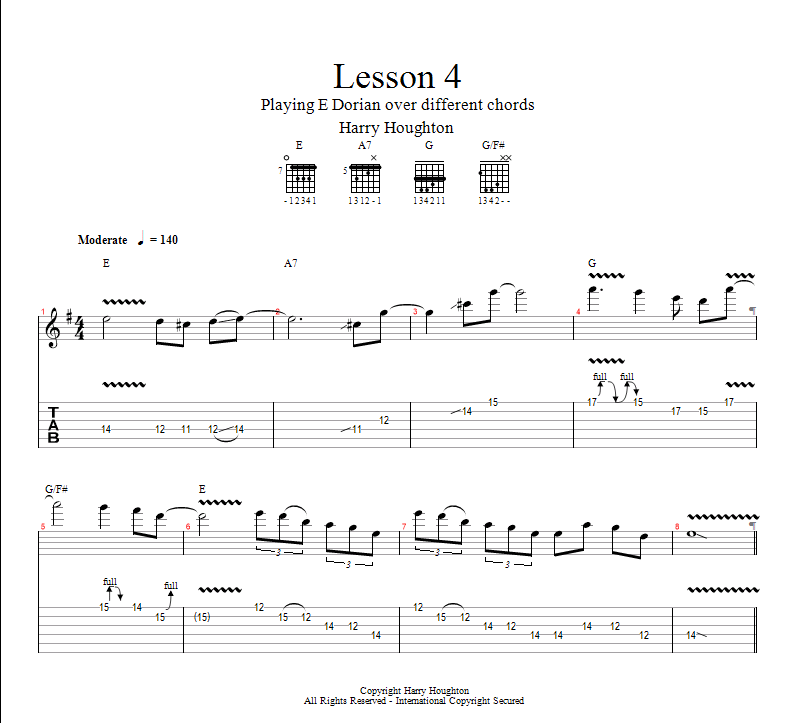This month’s lesson will involve playing the dorian mode over different chords and explain how to approach each chord. When playing over different chords, knowing the construction of the chords in the key you’re playing in help you decide which notes are best to target. For example, when playing over E minor targeting E, G and B will sound the most effective. That’s not to say you can’t play other notes, but to start or finish a phrase with these notes will help shape your melody.
This example starts on an E minor chord, and we begin with an E note at the fourteenth fret of the D string. We then go down the the D at the twelfth fret, and then the C# at the eleventh fret and then back the to the D and then the E all on the D string.
When we reach the E, the chord below changes to an A7 chord, which works well as E is the fifth of A. The 4 notes in an A7 chord are A, C#, E and G, and we then slide to the C# at the eleventh fret of the D string and then play a G note at the twelfth fret of the G string.
Then we play the same notes an octave above the fourteenth and fifteenth frets of the B and E strings. These notes work well over the A7 chord as C# is the major third of A and G is the dominant seventh.
Our chord progression then moves to a G major chord, and we emphasise this by bending from the A at the seventeenth fret of the high E string up a tone to the major third of G, which is B. We bend up and down and back up again, before bending down and then finishing on our home note of G at the fifteenth fret. Our next chord is a G/F# chord, which could be thought of as a inverted D major chord, and our melody notes reflect this.
We play the E and D notes at the seventeenth and fifteenth frets of the B string before finishing on an A at the seventeenth fret of the high E string, and adding vibrato. This works well as 2 out the 3 notes are in the chord of D (D being the root note and A being the fifth). The only other note in a D major chord is an F# which is where we are headed next.
Before we head back to our E minor chord, we bend up from the G at the fifteenth fret of the high E string a tone to the A (again highlighting the fifth of D), back down to G, and then down to F# (the third of D) at the fourteenth fret of the high E string. We then bend up from the fifteenth fret a tone from D to E and add vibrato.
We finish this 8 bar solo with a descending pentatonic lick which we repeat twice. It consists of a descending pentatonic scale in triplets from the E at the twelfth fret of the high E string, through D and B at the fifteenth and twelfth frets of the B string.
Then, through A and G at the fourteenth and twelfth frets of the G string and E at the fourteenth fret of the D string. We then repeat this and on beat 3 we play the E again then go up to the A at the fourteenth fret of the G string, back down to the G at the twelfth fret, then D at the twelfth fret of the D string and finishing at the E at the fourteenth fret and adding vibrato.




